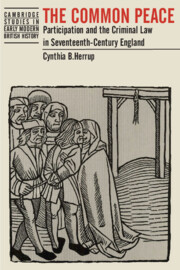Book contents
- Frontmatter
- Contents
- List of figures and tables
- Acknowledgments
- Glossary
- Abbreviations and conventions
- 1 The criminal law in early modern England
- 2 The setting
- 3 Judicial power and cooperation in eastern Sussex
- 4 From crime to criminal accusation
- 5 From accusation to indictment
- 6 From indictment to conviction
- 7 Becoming a criminal
- 8 The common peace
- Appendix 1 Summary of sampled courts
- Appendix 2 Status categories
- Bibliography
- Index
- Cambridge Studies in Early Modern British History
6 - From indictment to conviction
Published online by Cambridge University Press: 10 January 2011
- Frontmatter
- Contents
- List of figures and tables
- Acknowledgments
- Glossary
- Abbreviations and conventions
- 1 The criminal law in early modern England
- 2 The setting
- 3 Judicial power and cooperation in eastern Sussex
- 4 From crime to criminal accusation
- 5 From accusation to indictment
- 6 From indictment to conviction
- 7 Becoming a criminal
- 8 The common peace
- Appendix 1 Summary of sampled courts
- Appendix 2 Status categories
- Bibliography
- Index
- Cambridge Studies in Early Modern British History
Summary
The rituals of criminal trials in early modern England emphasized the responsibilities of petty jurors. At least three separate times in a trial, juror and defendant confronted one another. When suspects were ready to stand trial, the potential jurors and the arraigned defendants approached the Bar of the courtroom. The two groups stood face to face while the clerk presented the jury to the defendants: “These good men,” he said, “that were last called, and have appeared are those that shall pass between our Sovereign Lord the King and you upon your lives and deaths…” Unlike grand jurors, who were sworn collectively, petty jurors made their promises individually, each with his hand upon the Bible. The accepted procedural manual for clerks of the courts in the late seventeenth century recommended not only that a juror touch the Scriptures as he swore, but also that he look directly into the faces of the defendants. Any defendant could dismiss up to twenty potential jurors without specific cause by challenging the candidates when they moved forward to take the oath of office. To emphasize further the solemnity of the occasion, after taking their oaths, the petty jurors stood to either side of the Bar with the persons to be tried in between them. One by one, each prisoner was brought forward and instructed to raise his hand.
- Type
- Chapter
- Information
- The Common PeaceParticipation and the Criminal Law in Seventeenth-Century England, pp. 131 - 164Publisher: Cambridge University PressPrint publication year: 1987



